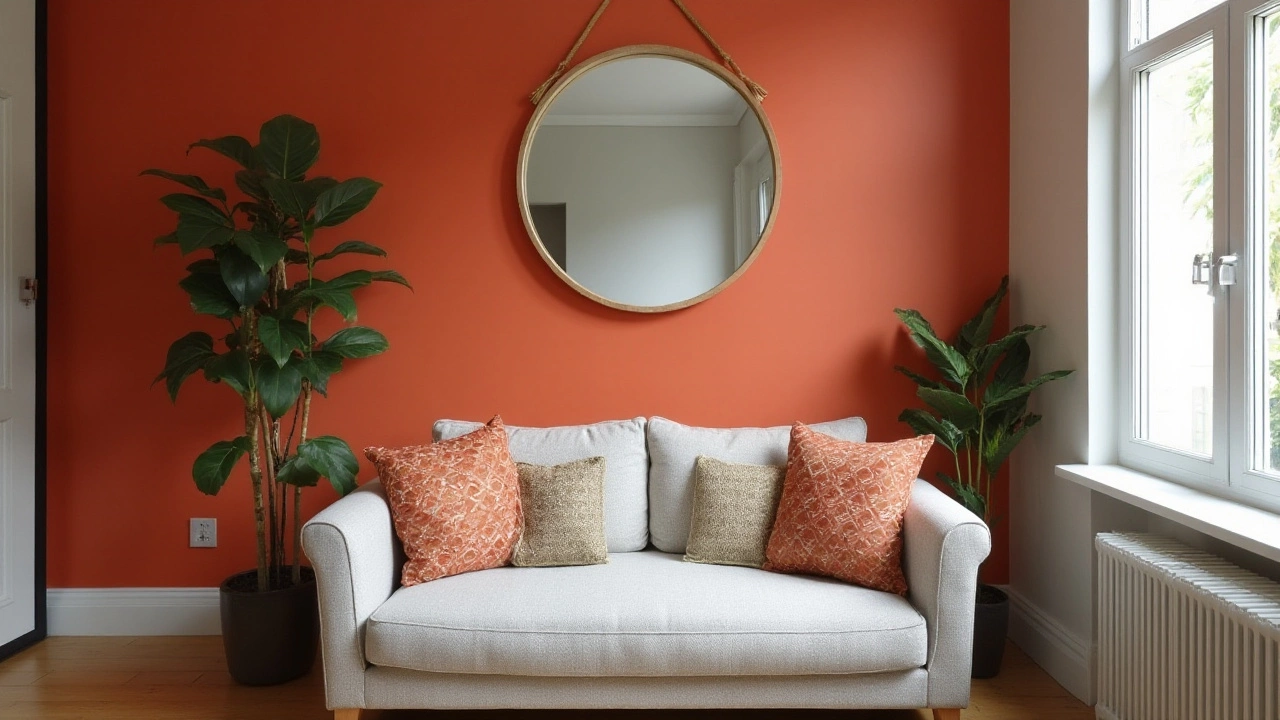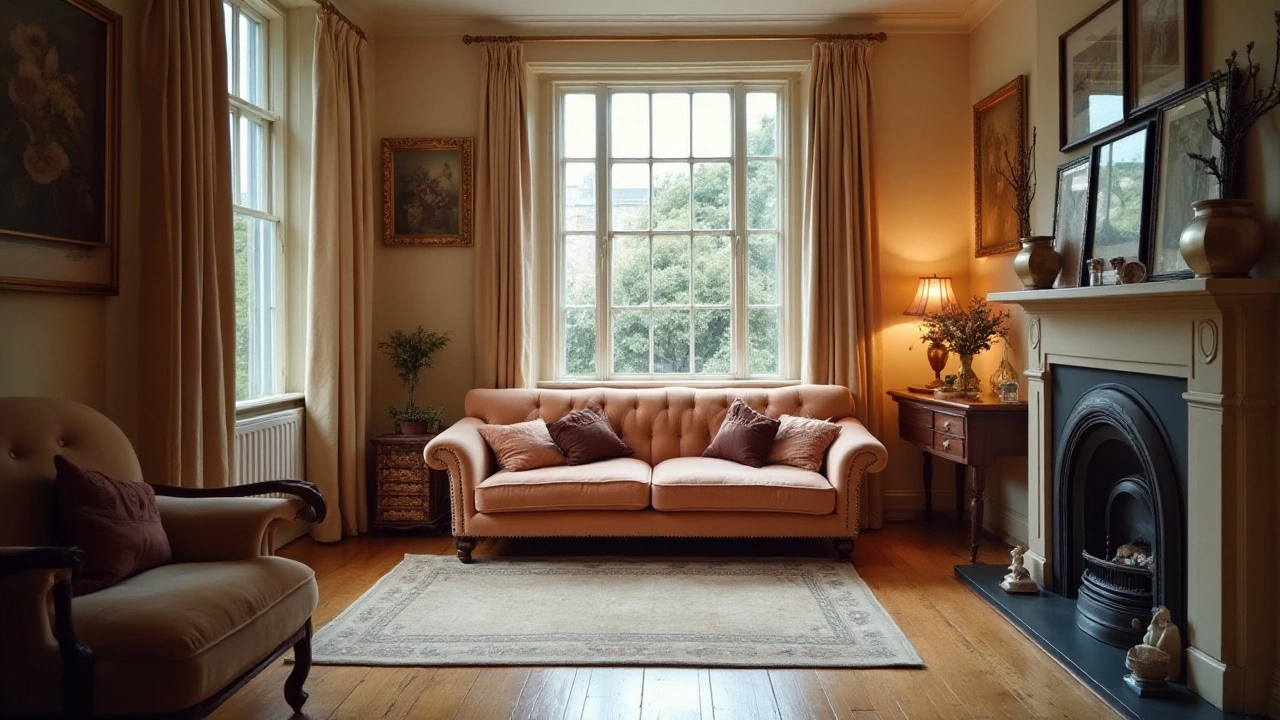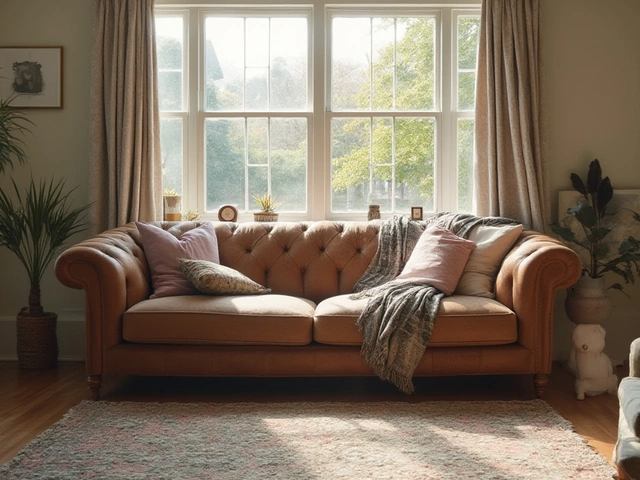When it comes to arranging a living room, where you place your couch can define the whole vibe of the space. It's not just about aesthetics; it's also about how the room functions. The age-old debate around whether a couch should nestle up against a wall is one many homeowners contemplate. While lining up your seating with a wall might seem like an obvious choice, it's worth exploring other possibilities that could open up your space.
The room's flow and functionality should guide your decision. Consider, for instance, how a conversation might naturally develop in the area. Perhaps there are opportunities to arrange furniture in ways that suit your lifestyle better. There's no one-size-fits-all answer, and often the choice depends heavily on the room's size, shape, and what you use it for.
- Understanding Space and Flow
- Impacts on Decor and Aesthetics
- Enhancing Conversation Areas
- Room Size Considerations
- Creative Alternatives to Wall Placement
- Practical Tips for Positioning a Couch
Understanding Space and Flow
When arranging your living room, understanding the dynamics of space and flow is key to creating a comfortable and functional environment. It's often surprising how much the position of a couch can influence not just the look, but the feel of a room. Think of it like this: space is the canvas, and furniture, including that all-important couch, is the medium through which you craft an inviting atmosphere. The flow, on the other hand, is all about the invisible pathways created within the room, directing how people move. It’s about ease of movement and intuitive pathways which make a space come alive. So, an appropriately placed couch should complement and contribute to both the space and the flow.
One fascinating aspect is how sofa positioning can visually alter perceived space. In tight quarters, pushing the couch against the wall might seem logical to maximize area. Yet, this traditional practice can sometimes make the room feel confined. By allowing even a little breathing room behind the couch, even the smallest spaces can feel a bit larger and calculated. This is counterintuitive but frequently true in design. On the other side, completely floating a couch in a large room grants the benefit of creating distinct zones for different purposes without adding walls or partitions.
Moreover, think about the flow of conversation. In social spaces, the arrangement should foster interaction. Analyze how a room naturally guides people to congregate. A couch facing another piece of furniture such as armchairs can nurture a cozy, inviting area for chatting or watching TV, encourage people to sit slightly more towards each other, promoting discussion. Interestingly, the Golden Ratio often influences design decisions, acknowledging that proportion can foster harmony even in humble living quarters.
In one of her lectures, designer Sarah Susanka shared, “A well-designed living space acts as an extension of its user's everyday needs and movements.” Indeed, Susanka’s wisdom implies that thoughtful furniture placement should align with daily living habits, moreover enhancing them, without hampering natural flow. It’s significant to note that what works for one home may not fit another. Shifting furniture around occasionally could be insightful, throwing the light on unnoticed needs or preferences you didn't initially recognize in your living area.
Impacts on Decor and Aesthetics
Arranging a couch against a wall is like choosing the setting for a painting in a gallery. It frames the piece while providing a backdrop that complements the foreground. The same principles apply within the confines of your living room. Having a couch placement against a wall can help create a structured, clean look that lends a certain elegance, particularly in smaller living spaces where maximizing floor area is crucial. By anchoring the sofa to a wall, you establish a clear boundary for the seating area, which can help maintain an organized appearance.
This arrangement often invites a more traditional decor style. It allows for the addition of decorative elements like gallery walls or shelving units above the couch, enhancing both vertical and horizontal lines in the room. A carefully curated selection of art or family photographs can add character and depth, making the room feel more personal and lived-in. This positioning can simultaneously highlight interesting architectural features like exposed brickwork or intricate wall patterns, giving the room added charisma without overwhelming the senses.
On the flip side, positioning a sofa away from the walls can be particularly beneficial in larger spaces or open floor plans. This can provide opportunities to establish distinct zones for different activities, such as relaxing, socializing, or dining. When you tease your sofa positioning away from the default wall hug, you introduce a more dynamic atmosphere. This could be an opportunity to place a console table behind the couch or to anchor a reading nook. As interior designer and author Sheila Bridges once mentioned in an interview, "Arranging furniture in non-traditional ways opens up the flow and often sparks unique conversational scenarios." The alternative layout encourages movement and interaction, promoting a more engaging living environment.
A living room layout that defies the standard wall-bound couch can lend itself to a more eclectic decorating style, showcasing a variety of furniture pieces which communicate together harmoniously. Look around at furniture stores and online catalogs—more frequently, you'll notice a mix-and-match approach that's currently in vogue. By allowing the sofa a more central role in the room rather than communication strictly with walls, you're also presenting an invitation to adorn both sides of the sofa with elements like plants or petite tables, filling up the void that might otherwise remain.
Statistics from home decor surveys reveal that about 60% of homeowners prefer sofas against the wall, predominantly due to limited space. Yet, the trend toward flexible living spaces is gaining traction. It's not unusual now to find living rooms where every square foot is planned for multipurpose use. Whether you desire a cozy reading corner, or a spacious area that encourages guests to mill about comfortably often influences this choice.
In short, the decision heavily depends on the desired mood, purpose, and the statement you wish the arrangement to make. It's a balance of style and practicality, a dance between form and function. So, when considering the question, "Should a couch be against a wall?", it's worth assessing the aesthetic ambitions, and whether it aligns with your vision for an inviting, versatile home.

Enhancing Conversation Areas
Creating a living room that encourages easy conversation often begins with thoughtful placement of the sofa. When chairs and couches are arranged to face one another, this setup naturally invites dialogue among guests and family members. Placing the couch in a manner that doesn't press against the wall can help achieve this interactive environment. Such an arrangement allows every person seated on the couch to face others directly, making eye contact easier and fostering engagement. In contrast, couches pushed to the walls may lead to obstructed lines of sight, which might lead people to crane their necks or sit uncomfortably.
Interior designers often emphasize the importance of the 'room within a room' concept to create inviting conversation spots. This involves using furniture to carve out a snug area within a larger space, acting almost like an island where people can gather. This idea supports the notion that a couch doesn’t always have to be against a wall; instead, it can float within a room to anchor this setup. As described by Nate Berkus, a renowned interior designer, "The way you position seating affects the way people use a space. Walking into a room and being naturally drawn to sit and talk is a sign of good furniture placement."
Strategically placed couch placement can also boost the aesthetic appeal of a conversation area. Rugs, coffee tables, or even low profile bookshelves can further delineate the borders of this space without the need for walls. Doing so not only enhances functionality but also merges form with function. This setup allows for greater creativity in decoration, with the potential to use elements like lighting or artwork to frame this social zone. Instead of a fixed backdrop provided by a wall, a floating arrangement opens up vistas for more dynamic decor approaches.
Moreover, flexibility is another advantage of this arrangement. A floating sofa configuration can easily be adapted for different events, from intimate family gatherings to lively social parties. Adding or removing seating becomes straightforward, as no piece is necessarily fixed in one position. This adaptability is crucial in homes where the living room serves multiple purposes, changing from a cozy reading nook to a vibrant party hub at different times. Thus, thinking outside the traditional wall-bound couch can add layers of versatility to your space.
Room Size Considerations
The size of your living room heavily influences where you might place your couch, and knowing how to create a balanced layout is essential. In smaller spaces, putting your sofa against a wall can free up valuable square footage, making the room feel a bit more expansive and open. This kind of arrangement can be crucial when you’re dealing with studio apartments or compact living areas where maximizing space is the top priority. With the couch placed snugly against a wall, you can arrange other necessary furniture like a coffee table or shelves more freely, ensuring there's enough room to walk around comfortably.
On the other hand, larger rooms offer more flexibility and creativity in sofa positioning. Here, moving your couch away from the walls can help define different zones within the space. For instance, you could use the couch as a divider to separate the living area from a dining nook or an office corner. This strategy not only enhances the functional aspects of the room but also boosts its visual appeal. By allowing easy flow between different spaces, you create a welcoming atmosphere where guests can feel relaxed and not confined.
Interestingly, a room’s dimensions aren't just about length and width; ceiling height plays a role too. In rooms with higher ceilings, a central placement of the couch often works better visually, as it draws the eye upwards and makes the room feel more cohesive. Conversely, in rooms with lower ceilings, sticking with traditional wall placement can help maintain a sense of spaciousness. According to interior design experts at Architectural Digest, "The way a couch is positioned can dramatically change the way a space feels, especially when it's utilized to emphasize or downplay certain architectural features."
When contemplating where to set your couch, lighting shouldn't be overlooked. Natural light can be a real added value, especially in rooms where windows offer scenic views or much-needed daylight. Situating your sofa in a position that allows for relaxation and absorption of natural light can create a cozy and warm lounging area. If the sun strikes too directly, consider using sheer curtains as a filter to maintain a soft, inviting glow while preserving a comfortable seating area.
Practical Tips Based on Room Size
- Small Rooms: Opt for a slim-profile sofa with lower backs to avoid overcrowding.
- Medium-Sized Rooms: Experiment with angular placements to create dynamic spaces.
- Large Rooms: Consider sectional sofas that offer ample seating and flexibility.
The key takeaway is that the arrangement of your living room should cater to your personal comfort as much as aesthetics. There are no rigid rules, so feel free to move pieces around until you find the most suitable setup that serves both your lifestyle and preferences.

Creative Alternatives to Wall Placement
When you think about placing a couch in a room, the default might be to push it against a wall. Yet, stepping outside this norm can reveal exciting opportunities to enhance your living area. Let's reimagine how sofas can be placed within a room to maximize both style and function. One alternative is using your sofa to create intimate zones within a larger space. By placing it in the middle of a room, you can divide areas while maintaining an open feel, ideal for homes with open-plan designs. This approach can beautifully distinguish a lounge area from a dining space without the need for any physical dividers.
Consider the backdrop your couch provides when it isn't hugged up against the wall. It can serve as a stunning feature when paired with a console table or a bookcase right behind it. This arrangement not only adds layers to your decor but also provides extra surfaces for decorations or practical storage. Architects and designers often suggest "floating" furniture away from walls to foster better conversation settings and improve room acoustics. A statement like "Rooms are meant to be lived in, so arranging furniture to facilitate conversation is key," says interior designer Nate Berkus, summarizes the idea perfectly.
An L-shaped or sectional sofa configuration offers yet another intriguing way to avoid traditional wall placement, especially in a living room layout that's a bit more eclectic. This can create a cozy nook that welcomes family and friends, encouraging them to gather and relax. If you are willing to experiment further, give a thought to placing your sofa at an angle. This can break up the predictability of rectangular spaces and introduce a bit of whimsy and dynamic energy to the room. Such angles are not just for aesthetics; they can be practical, directing traffic flow efficiently through spaces.
For those living in smaller spaces, it might seem counterintuitive at first to place a sofa away from a wall. However, this can be quite practical, offering unique storage solutions. Imagine sofas with hidden compartments or under-sofa storage bins that take advantage of the newfound space. What you'll find is that not only does the sofa positioning effect space perception dramatically, but it also gives an opportunity for clever designs that maximize every inch available. So next time you're contemplating where to place the couch, think beyond the wall and let creativity guide you. Discover how every piece of furniture can float or anchor the room in new and delightful ways.
Practical Tips for Positioning a Couch
Once you've zeroed in on a room's natural flow, it's time to think about how your couch placement can complement that. Start by considering the main focal points in the room. This could be a fireplace, a large window with a scenic view, or even a TV. Positioning your couch to face or flank these focal points can create a sense of harmony and intentional design. Maximize the sightlines by ensuring nothing obstructs the view from the couch to other significant pieces in the room, making it not just functional but also pleasing to the eye.
Don't forget the importance of conversation circles. Arranging your seating in a way that allows people to face each other naturally while maintaining a comfortable distance is key. Consider using additional seats like armchairs or love seats to complete the circle. Make sure the seating is close enough for conversation without having to raise voices, but also not too cramped. Also, don't overlook the importance of balance; an unbalanced furniture layout can make a room feel off-kilter and awkward.
Another essential aspect to keep in mind is the access points in and out of the room. You wouldn't want to place your couch in a way that blocks doors or creates awkward walkways. Allowing at least 18 to 24 inches of space for walkways around the couch makes the room accessible and comfortable. A little room in smaller spaces might require some clever angling to achieve this, but it's about being practical and imaginative with the space you have.
"Don't be afraid to float your sofa," suggests interior designer Emily Henderson. "Pull it away from the walls to create a more dynamic layout, and use art or floating shelves to lead the eye upward, making ceilings feel taller."
In smaller rooms, a closer inspection of your furniture's lines and shapes can offer solutions. Opt for a sleek, low-profile couch if ceiling height is an issue. This approach not only provides a modern look but also enables you to add accents like shelves or decorations on the walls above, which can draw the eye upwards, creating an illusion of space. Keep in mind that your couch doesn’t have to match walls or blend into them. Sometimes, contrast can help highlight your furniture thematically and visually.
The relationship between the seating and the lighting shouldn't be ignored either. Natural light can dictate how and where your couch should sit in the room. If the room is bright and sunny, placing your couch out of direct light can prevent fabric fading. On the flip side, darker rooms can benefit from couches near windows to make the most of the available light, thus enhancing the livability of the space.
Consider how the couch complements other furniture pieces. Integrating multi-use furniture like storage ottomans or coffee tables with integrated storage can serve dual purposes, achieving functionality without compromising space. This strategy can be particularly vital in smaller living spaces where maximizing every square foot is important. Arranging these pieces symmetrically around your couch can create a cohesive and inviting atmosphere where everything seems to fall naturally into place.



